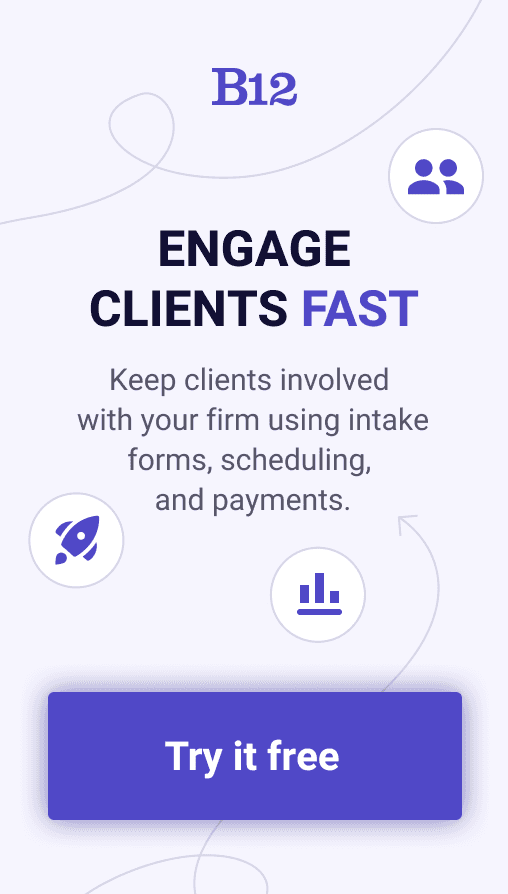Build an AI website in 60 seconds
AI generates your personalized website instantly with built-in scheduling, payments, email marketing, and more.
Start for free
What to include in your bookkeeping firm's client intake forms

As a bookkeeping firm, the successful onboarding of new clients is vital to your success. It all begins with a well-designed intake form that collects the necessary information to provide quality service to your new client. From basic contact information to detailed financial data, a thorough and efficient intake process is vital.
If you are unsure of how to create an effective intake form for your bookkeeping firm, this post is for you. In this blog post, we will discuss what information should be included in your bookkeeping firm's intake forms. We’ll also provide tips on how to collect it and the benefits of using templates and checklists. Keep reading to discover how to create an effective and efficient intake process that sets the stage for a successful partnership with your new clients.
Importance of a well-designed client intake form
When running a bookkeeping firm, keeping essential client information organized is critical for providing efficient and accurate services. That's where the client intake form enters the picture. A client intake form is a critical tool for collecting essential information from new clients. It enables the bookkeeping firm to establish a good working relationship with clients while also providing them with accurate and personalized financial services.
Nowadays, there is so much competition in the bookkeeping industry, so having a well-designed intake form can be a significant business differentiator. A professional and comprehensive intake form will create the right impression and help establish trust with new clients. It will also ensure that the bookkeeping firm provides clients with exceptional and complete services that suit their specific needs.
Basic information
The first step in creating a client intake form for your bookkeeping firm is to gather basic information about your client and their business. This includes their full name, business name, address, phone number, email address, and website. It is essential to ask for this information to ensure you can contact your client when needed and that all communications are accurate.
Name and business information
When designing your intake form, it is important to include separate fields for the client's name and their business name. This information should be collected, even if the client is a sole proprietor. Asking for multiple forms of identification (i.e., state-issued ID, passport, etc.) can also help reduce the risk of identity theft or fraud.
Collection methods
There are two primary methods for collecting client information- paper form and digital form. Paper forms can be distributed to clients during a face-to-face meeting or sent by email to clients. Digital forms can be accessed through the company's website or another secure online service. Depending on what method you choose, make sure the form is easy to read and complete.
Advantages of digital forms
Many bookkeeping firms prefer to use digital forms over paper ones, as they are more efficient and eco-friendly. Digital forms are often customizable and allow for faster data entry. If you opt for digital forms, consider investing in data encryption and other security measures to ensure sensitive information remains confidential. Some examples of digital form providers include Formstack, JotForm, and Google Forms.
Services required
When a new client approaches your bookkeeping firm, it's important to determine what services they require. Having a clear understanding of the client's needs is crucial for providing them with an accurate quote and ensuring that their expectations are met. Here's what you need to know when creating the services required section of your new client intake form.
List of services
It's essential to provide clients with a list of the services your firm offers. This allows clients to select the services they require and helps you to understand their needs. A clear and concise list of services helps clients to make informed decisions about which services they require and avoids any misunderstandings.
Importance of knowing what a client needs
Knowing what a client needs enables your firm to provide them with tailored solutions that meet their specific requirements. This means that the services provided are relevant and useful, which often results in a better working relationship. It's also an opportunity to upsell additional services that the client may not have been aware of.
Providing optional services
It's also useful to provide clients with the option of selecting additional services. This allows clients to be aware of what else your firm can provide in the future. It also shows that you are willing to go the extra mile to help clients grow their business.
Bookkeeping services checklist
Use a bookkeeping client checklist template to make sure you don't miss anything when it comes to outlining your firm's services. This type of template makes it easy to organize the list of services and ensures consistency across all clients. A checklist also helps to identify areas that may require additional attention, such as tax services or payroll management.
Importance of tax information
Collecting tax information is crucial for a bookkeeping firm to provide efficient and accurate services to its clients. The tax information needed goes beyond just the client's tax identification number. The bookkeeping firm should also know about the client's filing status, dependents, tax credits, deductions, and any other relevant tax information. Having access to this information ensures that the bookkeeping firm can provide a tailored service that meets the client's specific needs.
What type of tax information to collect
The bookkeeping firm should collect both personal and business tax information when onboarding a new client. Personal tax information includes the client's name, Social Security number, filing status, and dependents. Business tax information includes the company's tax identification number, number of employees, revenue, tax filing type, and other related details. Collecting all this information at the start of the relationship will prevent any confusion in the future and allow the bookkeeping firm to provide their clients with accurate and efficient tax returns.
Use of tax intake form and tax return intake sheet
To streamline the process of collecting tax information, bookkeeping firms can use a tax intake form or a tax return intake sheet. These forms can be customized to match the bookkeeping firm's needs and include all the necessary fields for tax information. The tax intake form is used to collect new client information, whereas the tax return intake sheet is used for existing clients who have changed their tax information. These forms ensure that the bookkeeping firm collects all the required information and creates a standard process for all clients.
The bookkeeping firm should collect both personal and business tax information for all new clients. By using tax intake forms and tax return intake sheets, the bookkeeping firm can create a standardized process and ensure that all necessary information is collected. This process will lead to efficient and tailored services for clients, which ultimately results in a better experience and a stronger relationship with their bookkeeping firm.
Company financial information
Obtaining a client's company financial information is vital for a bookkeeping firm to provide quality services. Here are the different types of financial information to collect and the tools that can be used to ensure accuracy.
Assets, liabilities, income, expenses, and equity
Bookkeeping firms need to collect a client's financial information to understand their business's current financial state. This information includes their assets, liabilities, income, expenses, and equity. Assets include cash and property, while liabilities are debts. The income is revenue earned, and expenses are the costs incurred by the business. Equity is the value of the business.
Getting accurate financial information from clients
To ensure the accuracy of a client's financial information, bookkeeping firms should use a bookkeeping client intake form and a new bookkeeping client questionnaire. These tools help firms get a comprehensive view of a client's finances. Firms should also ask for the client's bank statements, invoices, and receipts to verify the information provided.
Use of bookkeeping client intake form and new bookkeeping client questionnaire
The bookkeeping client intake form and new bookkeeping client questionnaire are essential tools to help firms collect financial information from new clients. The bookkeeping client intake form should have fields for assets, liabilities, income, expenses, and equity. The new bookkeeping client questionnaire should ask questions about the client's business operations and financial goals.
Importance of consistent, accurate, and timely financial information
Consistent, accurate, and timely financial information enables bookkeeping firms to provide the best services to their clients. Firms should maintain a schedule for collecting financial information from clients, preventing delays in providing quality services. Accurate financial information also aids the firm in making decisions related to clients' businesses and providing sound financial advice.
Recap and final thoughts
Creating a thorough and well-designed client intake form is crucial for any bookkeeping firm. It sets the foundation for a successful working relationship between the firm and its clients. With a proper form, the firm can better understand the needs of each client and provide customized services.
A well-designed client intake form can help a bookkeeping firm save time and effort when working with a new client. By collecting all relevant information upfront, the firm can avoid mistakes, misunderstandings, and miscommunications that may lead to costly errors down the line. It also helps the firm to tailor its services to meet the specific needs of the client.
In a client intake form, you must gather basic information, such as the client’s name, address, and contact information, as well as the services required. You should also collect tax and financial information.
We strongly recommend using templates and checklists to build consistency and efficiency in the client intake process. A standardized form can help ensure that the firm gathers all necessary information for each client and provides consistent services across the board. It can also save time and effort for the firm’s employees.
Create on-brand intake forms with B12
By taking the time to create a comprehensive and well-designed client intake form, bookkeeping firms can improve the quality of their services, build stronger relationships with clients, and enhance their overall efficiency and effectiveness.
With B12, you can easily generate intake forms and streamline your onboarding process. You can customize your bookkeeping client intake forms and even add the form to your website for more convenience.
B12r is an all-in-one platform for professional services. Attract leads, win business, and serve clients online with a powerful intake form solution. Sign up for free today.
Attract, win, and serve more clients
Receive helpful resources directly to your inbox to help you succeed online.
Draft your site in 60 seconds
Get an AI website made specifically for you that's free to launch.
Start for free ✨No credit card required
Spend less time on your website and more time growing your business
Let B12 set up your professional online presence with everything you need to attract, win, and serve clients.





